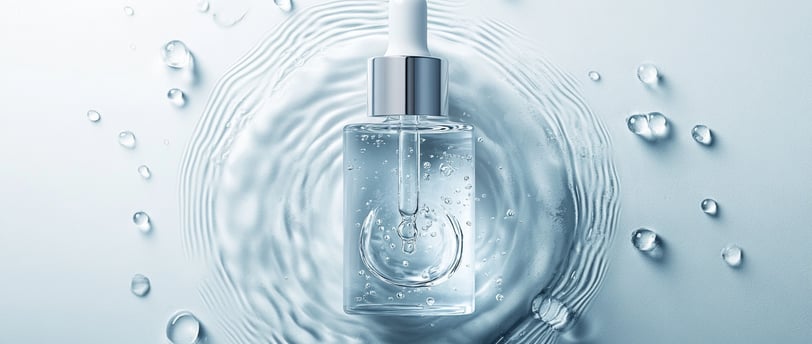Hyaluronic Acid: The Moisture Magnet Your Skin Will Love
If your skin ever feels tight, flaky, or just off — there's a good chance it's dehydrated. Enter hyaluronic acid (HA) — the skincare world’s favorite hydration booster. Found in everything from serums to moisturizers, hyaluronic acid has earned its spot as a go-to ingredient for plump, dewy, healthy-looking skin. But what exactly is it, and how does it compare to a regular lotion? Let’s break it down.
5/2/20253 min read


What Is Hyaluronic Acid?
Hyaluronic acid is a naturally occurring sugar molecule found in your skin, eyes, and connective tissue. Its superpower? Holding up to 1,000 times its weight in water — making it one of the most effective humectants in skincare.
When applied topically, it acts like a moisture magnet, drawing water into the top layer of your skin to keep it smooth, plump, and elastic.
Key Benefits of Hyaluronic Acid
1. Deep Hydration (Without the Grease)
Unlike heavier creams that can sit on top of the skin, HA pulls water into the skin’s surface, hydrating it from within — without clogging pores or feeling greasy.
2. Plumps Fine Lines
Dehydration exaggerates the look of fine lines. By increasing moisture in the skin, HA gives your face a smoother, fuller appearance.
3. Supports Skin Barrier
Hydrated skin is less prone to irritation and breakouts. HA helps maintain a strong barrier function, keeping environmental stressors out and moisture in.
4. Gentle and Universal
It’s non-comedogenic, non-irritating, and works for all skin types — dry, oily, sensitive, or acne-prone. Even rosacea-prone skin typically tolerates it well.
Serum vs. Moisturizer: How to Use Hyaluronic Acid Right
Many people get confused between HA serums and HA moisturizers — but they each play a distinct role:
Hyaluronic Acid Serum:
Lightweight, water-based, and designed to deliver a high concentration of HA directly into the skin.
Best applied on slightly damp skin, then sealed in with a moisturizer.
Hyaluronic Acid Moisturizer:
Combines HA with occlusives and emollients (like squalane, ceramides, or oils) to lock in hydration and smooth the surface.
Great as a one-step hydrator for those who prefer simplicity.
Hyaluronic Acid vs. Regular Moisturizer: What’s the Difference?
Both hyaluronic acid (HA) and traditional moisturizers aim to keep your skin hydrated — but they go about it in very different ways.
◾ Texture & Feel
HA serums are typically lightweight and watery, designed to absorb quickly and leave no residue. They feel almost weightless on the skin, which makes them perfect for layering. Regular moisturizers, on the other hand, are usually cream-based and may feel thicker or richer depending on the formula.
◾ Function
Hyaluronic acid is a humectant, which means it draws moisture into the skin — either from the air or from deeper skin layers. Moisturizers tend to act as occlusives or emollients, creating a barrier on the skin’s surface to lock in that moisture and prevent it from evaporating.
◾ When to Use
HA serums are best applied right after cleansing, while your skin is still slightly damp. This helps the ingredient pull in as much water as possible. Moisturizers should be applied after your HA serum, as the final step in your routine to help seal in hydration.
◾ Hydration Depth
Hyaluronic acid works within the upper layers of the skin, helping it feel plumper and more hydrated. Moisturizers sit on top of the skin and help reduce transepidermal water loss (TEWL), acting as a shield to keep moisture in.
◾ Best Results
They work best together — think of hyaluronic acid as the hydration booster, and your moisturizer as the seal that locks everything in. Skipping either one can limit how effective the other is.
Top 5 Hyaluronic Acid We Love
The Ordinary Hyaluronic Acid 2% + B5
Why it stands out: A budget-friendly favorite, this serum combines low, medium, and high molecular weight hyaluronic acid for multi-depth hydration, enhanced with vitamin B5 to support skin healing.
Ideal for: All skin types, especially those new to hyaluronic acid.
CeraVe Hydrating Hyaluronic Acid Serum
Why it stands out: Developed with dermatologists, this serum includes hyaluronic acid, vitamin B5, and three essential ceramides to restore the skin's natural barrier and provide long-lasting hydration.
Ideal for: Dry and sensitive skin.
La Roche-Posay Hyalu B5 Pure Hyaluronic Acid Serum
Why it stands out: This serum combines two types of pure hyaluronic acid with vitamin B5 and madecassoside to plump the skin and repair the moisture barrier. It's known for its lightweight texture and effectiveness.
Ideal for: Mature or dehydrated skin seeking anti-aging benefits.
L'Oréal Paris Revitalift 1.5% Pure Hyaluronic Acid Serum
Why it stands out: With a high concentration of pure hyaluronic acid, this serum visibly plumps skin and reduces wrinkles. It's fragrance-free and absorbs quickly without leaving a sticky residue.
Ideal for: Those seeking quick hydration and anti-aging effects.
Vichy Minéral 89 Hyaluronic Acid Face Serum
Why it stands out: This serum combines 89% Vichy volcanic water with hyaluronic acid to strengthen and hydrate the skin barrier. It's lightweight, non-greasy, and suitable for daily use.
Ideal for: All skin types, including sensitive skin
Pro Tips for Best Results
Apply HA to slightly damp skin (post-cleansing or misting) — this helps it attract water more effectively.
Always seal it in with a moisturizer, especially in dry climates. Otherwise, HA might pull moisture out of your skin.
Use it morning and night — it layers beautifully under sunscreen and makeup.
Final Thoughts
Hyaluronic acid isn’t just a trend — it’s a science-backed skincare essential. Whether you're targeting dryness, dullness, or just want that glowy, bouncy look, HA is a safe, gentle, and effective option to add to your routine.
And the best part? It plays well with others — so you can combine it with actives like vitamin C, niacinamide, or retinol to hydrate and protect your skin, no matter your goals.
